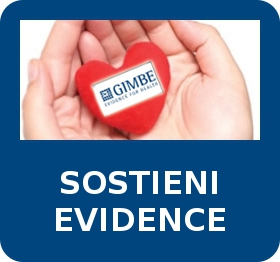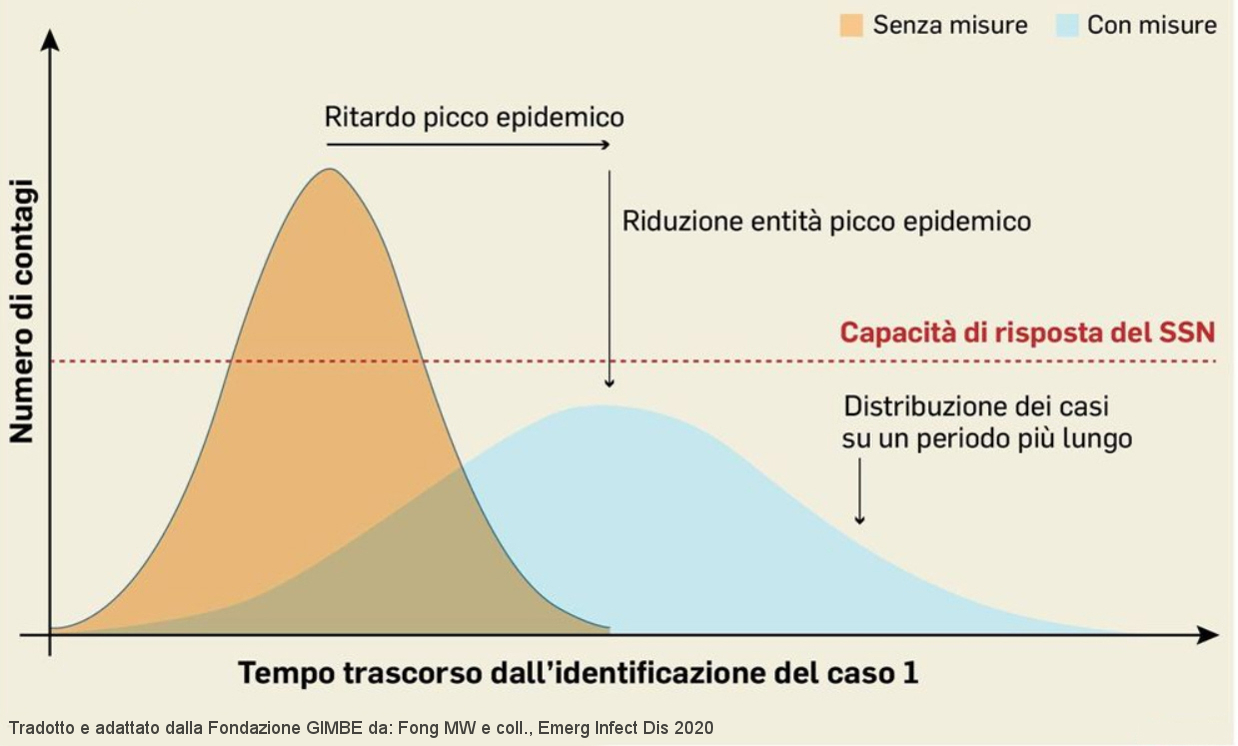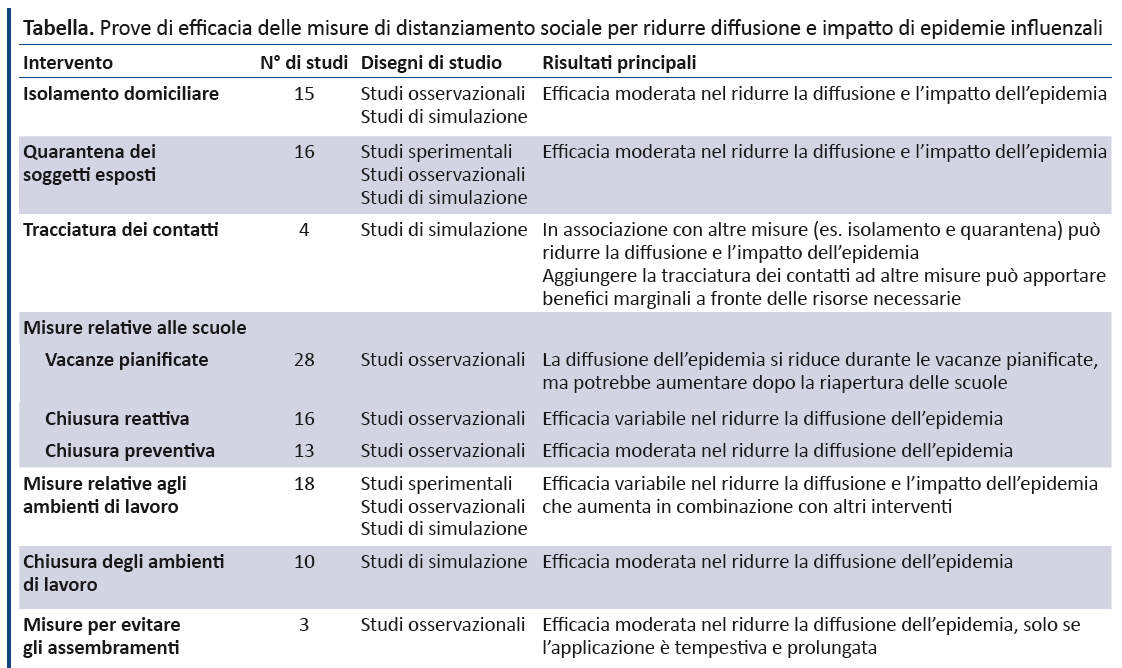Efficacia delle misure di distanziamento sociale
per contrastare le pandemie influenzali
Hot topics
Efficacia delle misure di distanziamento sociale
per contrastare le pandemie influenzali
Fondazione GIMBEEvidence 2020;12(3): e1000207 doi: 10.4470/E1000207
Pubblicato: 6 marzo 2020
Copyright: © 2020 Fondazione GIMBE Questo è un articolo open-access, distribuito con licenza Creative Commons Attribution, che ne consente l’utilizzo, la distribuzione e la riproduzione su qualsiasi supporto esclusivamente per fini non commerciali, a condizione di riportare sempre autore e citazione originale.
1. Centers for Disease Control and Prevention. Pandemic influenza, 2019. Disponibile a: www.cdc.gov/flu/pandemic-resources/index.htm. Ultimo accesso: 5 marzo 2020.
2. Ahmed F, Zviedrite N, Uzicanin A. Effectiveness of workplace social distancing measures in reducing influenza transmission: a systematic review. BMC Public Health 2018;18:518.
3. European Centre for Disease Prevention and Control. Guide to public health measures to reduce the impact of influenza pandemics in Europe: The ECDC Menu. Stockholm: The Centre; 2009.
4. Qualls N, Levitt A, Kanade N, Wright-Jegede N, Dopson S, Biggerstaff M, e coll.; CDC Community Mitigation Guidelines Work Group. Community mitigation guidelines to prevent pandemic influenza—United States, 2017. MMWR Recomm Rep.2017;66:1–34.
5. Bell D, Nicoll A, Fukuda K, Horby P, Monto A, Hayden F, e coll.; World Health Organization Writing Group. Non-pharmaceutical interventions for pandemic influenza, international measures. Emerg Infect Dis 2006;12:81–7.
6. Markel H, Lipman HB, Navarro JA, Sloan A, Michalsen JR, Stern AM, e coll. Nonpharmaceutical interventions implemented by US cities during the 1918-1919 influenza pandemic JAMA 2007;298:644–54.
7. Caley P, Philp DJ, McCracken K. Quantifying social distancing arising from pandemic influenza. J R Soc Interface.2008;5:631–9.
8. Chu CY, de Silva UC, Guo JP, Wang Y, Wen L, Lee VJ, e coll. Combined interventions for mitigation of an influenza A (H1N1) 2009 outbreak in a physical training camp in Beijing, China. Int J Infect Dis 2017;60:77–82.
9. Gaillat J, Dennetière G, Raffin-Bru E, Valette M, Blanc MC. Summer influenza outbreak in a home for the elderly: application of preventive measures. J Hosp Infect. 2008;70:272–7.
10. Vera DM, Hora RA, Murillo A, Wong JF, Torre AJ, Wang D, e coll. Assessing the impact of public health interventions on the transmission of pandemic H1N1 influenza a virus aboard a Peruvian navy ship. Influenza Other Respir Viruses 2014;8:353-9.
11. Fraser C, Riley S, Anderson RM, Ferguson NM. Factors that make an infectious disease outbreak controllable. Proc Natl Acad Sci USA 2004;101:6146–51.
12. Centers for Disease Control and Prevention. Influenza (flu) preventive steps, 2018. Disponibile a: www.cdc.gov/flu/prevent/prevention.htm. Ultimo accesso: 5 marzo 2020.
13. Cowling BJ, Chan KH, Fang VJ, Lau LLH, So HC, Fung ROP, e coll. Comparative epidemiology of pandemic and seasonal influenza A in households. N Engl J Med 2010;362:2175–84.
14. Patrozou E, Mermel LA. Does influenza transmission occur from asymptomatic infection or prior to symptom onset? Public Health Rep 2009;124:193–6.
15. Wu JT, Riley S, Fraser C, Leung GM. Reducing the impact of the next influenza pandemic using household-based public health interventions. PLoS Med 2006;3:e361.
16. Peak CM, Childs LM, Grad YH, Buckee CO. Comparing nonpharmaceutical interventions for containing emerging epidemics. Proc Natl Acad Sci U S A 2017;114:4023–8.
17. An der Heiden M, Buchholz U, Krause G, Kirchner G, Claus H, Haas WH. Breaking the waves: modelling the potential impact of public health measures to defer the epidemic peak of novel influenza A/H1N1. PLoS One 2009;4:e8356.
18. Miyaki K, Sakurazawa H, Mikurube H, Nishizaka M, Ando H, Song Y, e coll. An effective quarantine measure reduced the total incidence of influenza A H1N1 in the workplace: another way to control the H1N1 flu pandemic. J Occup Health 2011;53:287–92.
19. Fujita M, Sato H, Kaku K, Tokuno S, Kanatani Y, Suzuki S, e coll. Airport quarantine inspection, follow-up observation, and the prevention of pandemic influenza. Aviat Space Environ Med 2011;82:782–9.
20. Li X, Geng W, Tian H, Lai D. Was mandatory quarantine necessary in China for controlling the 2009 H1N1 pandemic? Int J Environ Res Public Health 2013;10:4690–700.
21. van Gemert C, Hellard M, McBryde ES, Fielding J, Spelman T, Higgins N, e coll. Intrahousehold transmission of pandemic (H1N1) 2009 virus, Victoria, Australia. Emerg Infect Dis 2011;17:1599–607.
22. McLeod MA, Baker M, Wilson N, Kelly H, Kiedrzynski T, Kool JL. Protective effect of maritime quarantine in South Pacific jurisdictions, 1918-19 influenza pandemic. Emerg Infect Dis 2008;14:468–70.
23. Ferguson NM, Cummings DA, Fraser C, Cajka JC, Cooley PC, Burke DS. Strategies for mitigating an influenza pandemic. Nature 2006;442:448–52.
24. World Health Organization. Ethical considerations in developing a public health response to pandemic influenza. Report no. WHO/CDS/EPR/GIP/2007.2. Geneva: The Organization; 2007.
25. Lessler J, Reich NG, Brookmeyer R, Perl TM, Nelson KE, Cummings DA. Incubation periods of acute respiratory viral infections: a systematic review. Lancet Infect Dis 2009;9:291–300.
26. Rothstein MA, Talbott MK. Encouraging compliance with quarantine: a proposal to provide job security and income replacement. Am J Public Health 2007;97(Suppl 1):S49–56.
27. Jackson C, Vynnycky E, Hawker J, Olowokure B, Mangtani P. School closures and influenza: systematic review of epidemiological studies. BMJ Open 2013;3:e002149.
28. Cauchemez S, Ferguson NM, Wachtel C, Tegnell A, Saour G, Duncan B, e coll. Closure of schools during an influenza pandemic. Lancet Infect Dis 2009;9:473–81.
29. Bootsma MC, Ferguson NM. The effect of public health measures on the 1918 influenza pandemic in U.S. cities. Proc Natl Acad Sci U S A. 2007;104:7588–93.
30. Cowling BJ, Lau MS, Ho LM, Chuang SK, Tsang T, Liu SH, e coll. The effective reproduction number of pandemic influenza: prospective estimation. Epidemiology 2010;21:842–6.
31. Wu JT, Cowling BJ, Lau EH, Ip DK, Ho LM, Tsang T, e coll. School closure and mitigation of pandemic (H1N1) 2009, Hong Kong. Emerg Infect Dis 2010;16:538–41.
32. Kawano S, Kakehashi M. Substantial impact of school closure on the transmission dynamics during the pandemic flu H1N1–2009 in Oita, Japan. PLoS One 2015;10:e0144839.
33. Sato T, Akita T, Tanaka J. Evaluation of strategies for control and prevention of pandemic influenza (H1N1pdm) in Japanese children attending school in a rural town. Simulation using mathematical models. Nihon Koshu Eisei Zasshi 2013;60:204–11.
34. Chen T, Huang Y, Liu R, Xie Z, Chen S, Hu G. Evaluating the effects of common control measures for influenza A (H1N1) outbreak at school in China: A modeling study. PLoS One 2017;12:e0177672.
35. Chen T, Zhao B, Liu R, Zhang X, Xie Z, Chen S. Simulation of key interventions for seasonal influenza outbreak control at school in Changsha, China. J Int Med Res 2020;48(1), 300060518764268
36. Cauchemez S, Bhattarai A, Marchbanks TL, Fagan RP, Ostroff S, Ferguson NM, e coll.; Pennsylvania H1N1 working group. Role of social networks in shaping disease transmission during a community outbreak of 2009 H1N1 pandemic influenza. Proc Natl Acad Sci U S A 2011;108:2825–30.
37. Luca G, Kerckhove KV, Coletti P, Poletto C, Bossuyt N, Hens N, e coll. The impact of regular school closure on seasonal influenza epidemics: a data-driven spatial transmission model for Belgium. BMC Infect Dis 2018;18:29.
38. Te Beest DE, Birrell PJ, Wallinga J, De Angelis D, van Boven M. Joint modelling of serological and hospitalization data reveals that high levels of pre-existing immunity and school holidays shaped the influenza A pandemic of 2009 in the Netherlands. J R Soc Interface 2015;12:20141244.
39. Birrell PJ, Ketsetzis G, Gay NJ, Cooper BS, Presanis AM, Harris RJ, e coll. Bayesian modeling to unmask and predict influenza A/H1N1pdm dynamics in London. Proc Natl Acad Sci U S A 2011;108:18238–43.
40. Chowell G, Towers S, Viboud C, Fuentes R, Sotomayor V. Rates of influenza-like illness and winter school breaks, Chile, 2004-2010. Emerg Infect Dis 2014;20:1203–7.
41. Chu Y, Wu Z, Ji J, Sun J, Sun X, Qin G, e coll. Effects of school breaks on influenza-like illness incidence in a temperate Chinese region: an ecological study from 2008 to 2015. BMJ Open 2017;7:e013159.
42. Germann TC, Gao H, Gambhir M, Plummer A, Biggerstaff M, Reed C, e coll. School dismissal as a pandemic influenza response: When, where and for how long? Epidemics 2019;28:100348.
43. Reich NG, Brooks LC, Fox SJ, Kandula S, McGowan CJ, Moore E, e coll. A collaborative multiyear, multimodel assessment of seasonal influenza forecasting in the United States. Proc Natl Acad Sci U S A 2019;116:3146–54.
44. Asfaw A, Rosa R, Pana-Cryan R. Potential economic benefits of paid sick leave in reducing absenteeism related to the spread of influenza-like illness. J Occup Environ Med 2017;59:822–9.
45. Piper K, Youk A, James AE III, Kumar S. Paid sick days and stay-at-home behavior for influenza. PLoS One 2017;12:e0170698.
46. Zhai Y, Santibanez TA, Kahn KE, Black CL, de Perio MA. Paid sick leave benefits, influenza vaccination, and taking sick days due to influenza-like illness among U.S. workers. Vaccine 2018;36:7316–23.
47. Ahmed F, Kim S, Nowalk MP, King JP, VanWormer JJ, Gaglani M, e coll. Paid leave and access to telework as work attendance determinants during acute respiratory illness, United States, 2017–2018. Emerg Infect Dis 2020;26:26.
48. Hatchett RJ, Mecher CE, Lipsitch M. Public health interventions and epidemic intensity during the 1918 influenza pandemic. Proc Natl Acad Sci U S A 2007;104:7582–7.
49. Staff M, Torres MI. An influenza outbreak among pilgrims sleeping at a school without purpose built overnight accommodation facilities. Commun Dis Intell Q Rep 2011;35:10–5.
50. Leung NH, Xu C, Ip DK, Cowling BJ. The fraction of influenza virus infections that are asymptomatic: a systematic review and meta-analysis. Epidemiology 2015;26:862–72.
2. Ahmed F, Zviedrite N, Uzicanin A. Effectiveness of workplace social distancing measures in reducing influenza transmission: a systematic review. BMC Public Health 2018;18:518.
3. European Centre for Disease Prevention and Control. Guide to public health measures to reduce the impact of influenza pandemics in Europe: The ECDC Menu. Stockholm: The Centre; 2009.
4. Qualls N, Levitt A, Kanade N, Wright-Jegede N, Dopson S, Biggerstaff M, e coll.; CDC Community Mitigation Guidelines Work Group. Community mitigation guidelines to prevent pandemic influenza—United States, 2017. MMWR Recomm Rep.2017;66:1–34.
5. Bell D, Nicoll A, Fukuda K, Horby P, Monto A, Hayden F, e coll.; World Health Organization Writing Group. Non-pharmaceutical interventions for pandemic influenza, international measures. Emerg Infect Dis 2006;12:81–7.
6. Markel H, Lipman HB, Navarro JA, Sloan A, Michalsen JR, Stern AM, e coll. Nonpharmaceutical interventions implemented by US cities during the 1918-1919 influenza pandemic JAMA 2007;298:644–54.
7. Caley P, Philp DJ, McCracken K. Quantifying social distancing arising from pandemic influenza. J R Soc Interface.2008;5:631–9.
8. Chu CY, de Silva UC, Guo JP, Wang Y, Wen L, Lee VJ, e coll. Combined interventions for mitigation of an influenza A (H1N1) 2009 outbreak in a physical training camp in Beijing, China. Int J Infect Dis 2017;60:77–82.
9. Gaillat J, Dennetière G, Raffin-Bru E, Valette M, Blanc MC. Summer influenza outbreak in a home for the elderly: application of preventive measures. J Hosp Infect. 2008;70:272–7.
10. Vera DM, Hora RA, Murillo A, Wong JF, Torre AJ, Wang D, e coll. Assessing the impact of public health interventions on the transmission of pandemic H1N1 influenza a virus aboard a Peruvian navy ship. Influenza Other Respir Viruses 2014;8:353-9.
11. Fraser C, Riley S, Anderson RM, Ferguson NM. Factors that make an infectious disease outbreak controllable. Proc Natl Acad Sci USA 2004;101:6146–51.
12. Centers for Disease Control and Prevention. Influenza (flu) preventive steps, 2018. Disponibile a: www.cdc.gov/flu/prevent/prevention.htm. Ultimo accesso: 5 marzo 2020.
13. Cowling BJ, Chan KH, Fang VJ, Lau LLH, So HC, Fung ROP, e coll. Comparative epidemiology of pandemic and seasonal influenza A in households. N Engl J Med 2010;362:2175–84.
14. Patrozou E, Mermel LA. Does influenza transmission occur from asymptomatic infection or prior to symptom onset? Public Health Rep 2009;124:193–6.
15. Wu JT, Riley S, Fraser C, Leung GM. Reducing the impact of the next influenza pandemic using household-based public health interventions. PLoS Med 2006;3:e361.
16. Peak CM, Childs LM, Grad YH, Buckee CO. Comparing nonpharmaceutical interventions for containing emerging epidemics. Proc Natl Acad Sci U S A 2017;114:4023–8.
17. An der Heiden M, Buchholz U, Krause G, Kirchner G, Claus H, Haas WH. Breaking the waves: modelling the potential impact of public health measures to defer the epidemic peak of novel influenza A/H1N1. PLoS One 2009;4:e8356.
18. Miyaki K, Sakurazawa H, Mikurube H, Nishizaka M, Ando H, Song Y, e coll. An effective quarantine measure reduced the total incidence of influenza A H1N1 in the workplace: another way to control the H1N1 flu pandemic. J Occup Health 2011;53:287–92.
19. Fujita M, Sato H, Kaku K, Tokuno S, Kanatani Y, Suzuki S, e coll. Airport quarantine inspection, follow-up observation, and the prevention of pandemic influenza. Aviat Space Environ Med 2011;82:782–9.
20. Li X, Geng W, Tian H, Lai D. Was mandatory quarantine necessary in China for controlling the 2009 H1N1 pandemic? Int J Environ Res Public Health 2013;10:4690–700.
21. van Gemert C, Hellard M, McBryde ES, Fielding J, Spelman T, Higgins N, e coll. Intrahousehold transmission of pandemic (H1N1) 2009 virus, Victoria, Australia. Emerg Infect Dis 2011;17:1599–607.
22. McLeod MA, Baker M, Wilson N, Kelly H, Kiedrzynski T, Kool JL. Protective effect of maritime quarantine in South Pacific jurisdictions, 1918-19 influenza pandemic. Emerg Infect Dis 2008;14:468–70.
23. Ferguson NM, Cummings DA, Fraser C, Cajka JC, Cooley PC, Burke DS. Strategies for mitigating an influenza pandemic. Nature 2006;442:448–52.
24. World Health Organization. Ethical considerations in developing a public health response to pandemic influenza. Report no. WHO/CDS/EPR/GIP/2007.2. Geneva: The Organization; 2007.
25. Lessler J, Reich NG, Brookmeyer R, Perl TM, Nelson KE, Cummings DA. Incubation periods of acute respiratory viral infections: a systematic review. Lancet Infect Dis 2009;9:291–300.
26. Rothstein MA, Talbott MK. Encouraging compliance with quarantine: a proposal to provide job security and income replacement. Am J Public Health 2007;97(Suppl 1):S49–56.
27. Jackson C, Vynnycky E, Hawker J, Olowokure B, Mangtani P. School closures and influenza: systematic review of epidemiological studies. BMJ Open 2013;3:e002149.
28. Cauchemez S, Ferguson NM, Wachtel C, Tegnell A, Saour G, Duncan B, e coll. Closure of schools during an influenza pandemic. Lancet Infect Dis 2009;9:473–81.
29. Bootsma MC, Ferguson NM. The effect of public health measures on the 1918 influenza pandemic in U.S. cities. Proc Natl Acad Sci U S A. 2007;104:7588–93.
30. Cowling BJ, Lau MS, Ho LM, Chuang SK, Tsang T, Liu SH, e coll. The effective reproduction number of pandemic influenza: prospective estimation. Epidemiology 2010;21:842–6.
31. Wu JT, Cowling BJ, Lau EH, Ip DK, Ho LM, Tsang T, e coll. School closure and mitigation of pandemic (H1N1) 2009, Hong Kong. Emerg Infect Dis 2010;16:538–41.
32. Kawano S, Kakehashi M. Substantial impact of school closure on the transmission dynamics during the pandemic flu H1N1–2009 in Oita, Japan. PLoS One 2015;10:e0144839.
33. Sato T, Akita T, Tanaka J. Evaluation of strategies for control and prevention of pandemic influenza (H1N1pdm) in Japanese children attending school in a rural town. Simulation using mathematical models. Nihon Koshu Eisei Zasshi 2013;60:204–11.
34. Chen T, Huang Y, Liu R, Xie Z, Chen S, Hu G. Evaluating the effects of common control measures for influenza A (H1N1) outbreak at school in China: A modeling study. PLoS One 2017;12:e0177672.
35. Chen T, Zhao B, Liu R, Zhang X, Xie Z, Chen S. Simulation of key interventions for seasonal influenza outbreak control at school in Changsha, China. J Int Med Res 2020;48(1), 300060518764268
36. Cauchemez S, Bhattarai A, Marchbanks TL, Fagan RP, Ostroff S, Ferguson NM, e coll.; Pennsylvania H1N1 working group. Role of social networks in shaping disease transmission during a community outbreak of 2009 H1N1 pandemic influenza. Proc Natl Acad Sci U S A 2011;108:2825–30.
37. Luca G, Kerckhove KV, Coletti P, Poletto C, Bossuyt N, Hens N, e coll. The impact of regular school closure on seasonal influenza epidemics: a data-driven spatial transmission model for Belgium. BMC Infect Dis 2018;18:29.
38. Te Beest DE, Birrell PJ, Wallinga J, De Angelis D, van Boven M. Joint modelling of serological and hospitalization data reveals that high levels of pre-existing immunity and school holidays shaped the influenza A pandemic of 2009 in the Netherlands. J R Soc Interface 2015;12:20141244.
39. Birrell PJ, Ketsetzis G, Gay NJ, Cooper BS, Presanis AM, Harris RJ, e coll. Bayesian modeling to unmask and predict influenza A/H1N1pdm dynamics in London. Proc Natl Acad Sci U S A 2011;108:18238–43.
40. Chowell G, Towers S, Viboud C, Fuentes R, Sotomayor V. Rates of influenza-like illness and winter school breaks, Chile, 2004-2010. Emerg Infect Dis 2014;20:1203–7.
41. Chu Y, Wu Z, Ji J, Sun J, Sun X, Qin G, e coll. Effects of school breaks on influenza-like illness incidence in a temperate Chinese region: an ecological study from 2008 to 2015. BMJ Open 2017;7:e013159.
42. Germann TC, Gao H, Gambhir M, Plummer A, Biggerstaff M, Reed C, e coll. School dismissal as a pandemic influenza response: When, where and for how long? Epidemics 2019;28:100348.
43. Reich NG, Brooks LC, Fox SJ, Kandula S, McGowan CJ, Moore E, e coll. A collaborative multiyear, multimodel assessment of seasonal influenza forecasting in the United States. Proc Natl Acad Sci U S A 2019;116:3146–54.
44. Asfaw A, Rosa R, Pana-Cryan R. Potential economic benefits of paid sick leave in reducing absenteeism related to the spread of influenza-like illness. J Occup Environ Med 2017;59:822–9.
45. Piper K, Youk A, James AE III, Kumar S. Paid sick days and stay-at-home behavior for influenza. PLoS One 2017;12:e0170698.
46. Zhai Y, Santibanez TA, Kahn KE, Black CL, de Perio MA. Paid sick leave benefits, influenza vaccination, and taking sick days due to influenza-like illness among U.S. workers. Vaccine 2018;36:7316–23.
47. Ahmed F, Kim S, Nowalk MP, King JP, VanWormer JJ, Gaglani M, e coll. Paid leave and access to telework as work attendance determinants during acute respiratory illness, United States, 2017–2018. Emerg Infect Dis 2020;26:26.
48. Hatchett RJ, Mecher CE, Lipsitch M. Public health interventions and epidemic intensity during the 1918 influenza pandemic. Proc Natl Acad Sci U S A 2007;104:7582–7.
49. Staff M, Torres MI. An influenza outbreak among pilgrims sleeping at a school without purpose built overnight accommodation facilities. Commun Dis Intell Q Rep 2011;35:10–5.
50. Leung NH, Xu C, Ip DK, Cowling BJ. The fraction of influenza virus infections that are asymptomatic: a systematic review and meta-analysis. Epidemiology 2015;26:862–72.





